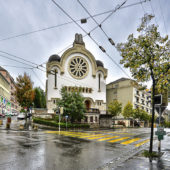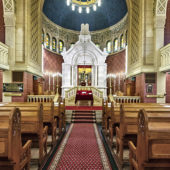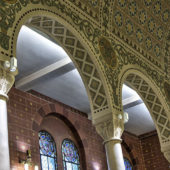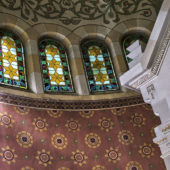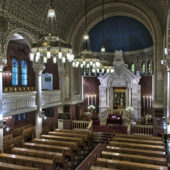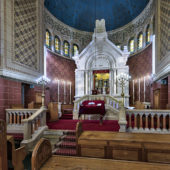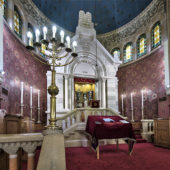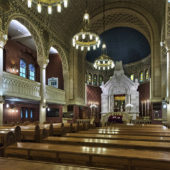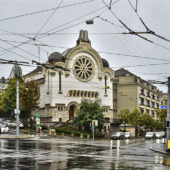A meticulously detailed building modeled after the Buffault Synagogue of Paris, France.
For centuries there were few Jews in Switzerland because they were often persecuted as they were elsewhere in Western Europe. They were even subject to special taxes and laws restricting their travel. In 1776 Jews were permitted to live in only one Swiss Canton, Aargau, and in only two of its towns: Lengnau and Endingen. Restrictions on Jews were gradually lifted. By 1879 the Jews of Aargau achieved total equality with other Swiss citizens and Jewish communities were gradually established in other Swiss towns.
By 1880 there were 7,373 Jews in Switzerland: less than 1/3 of 1% of the population. A wave of Jews fleeing pogroms in Eastern Europe started arriving in the early 20th century, changing the nature of Swiss Jewry. During the Nazi period in Germany, Switzerland turned back many would-be refugees; however 23,000 Jews did find refuge in the country. The 2000 census put the number of Jews in Switzerland at 17,900 (not counting those who may have described themselves as having no religious affiliation.) A third of Swiss Jews live in Zurich. Around half of them are ultra-orthodox. .
During the 1800s Jewish religious services took place in a single rented room. By 1895 the CIL (Israelite Community of Lausanne) was considering the possibility of a synagogue building. In May of that year a certain Mr. Schmidt offered the CIL a building for CHF 40,000 (40 thousand Swiss Francs). The purchase was not made as the cost was too great for the CIL which had only 41 members, 13 of whom lived outside Lausanne. The synagogue building project was not abandoned and a year later another building was leased but the owner backed out of the lease. .
In February of 1907 the Bordeaux banker, Daniel Iffla-Osiris, died at his home in Paris with no heirs to inherit his estate. Mr. Osiris was extremely philanthropic, supporting the construction of numerous public statues and buildings including the Sephardic Synagogue on rue Buffault in Paris. In his last will and testament there was the following provision: “I give and bequeath to the city of Lausanne the sum of fifty thousand francs to raise a Jewish temple, of which it will draw for the construction on that I did build in Paris, rue Buffault, with reproduction of existing plaques in this Temple, except the following inscriptions “to my parents”, “my friends” which are engraved. ” .
Fifty-thousand francs was not nearly a large enough sum to construct a building as big as the Buffault Synagogue. However, as Lausanne&rsquo-s Jewish community was much smaller than that served by the Buffault, the executors of Osiris’s estate agreed that a smaller synagogue, suitable in size for the CIL could be built with the inheritance. The first stone of the new synagogue was laid on June 29, 1908. By the time it was complete, the Lausanne Synagogue cost more the CHF 300,000, financed in part by a mortagge loan of CHF 175,000 to the CIL by Credit Foncier. Inauguration of the new synagogue took place November 7, 1910.

